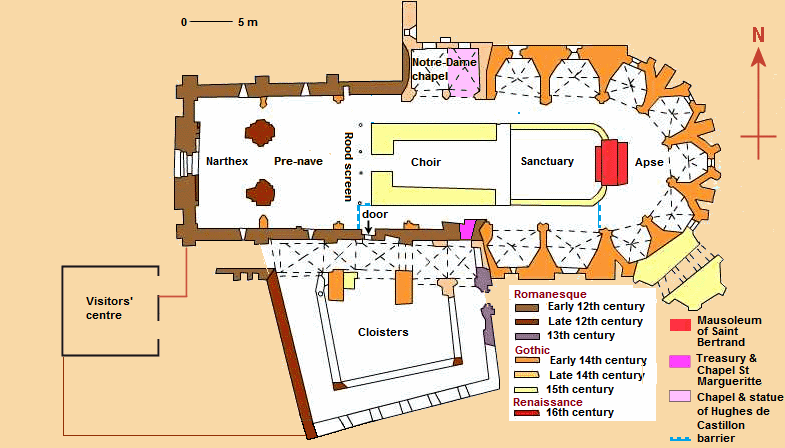
|
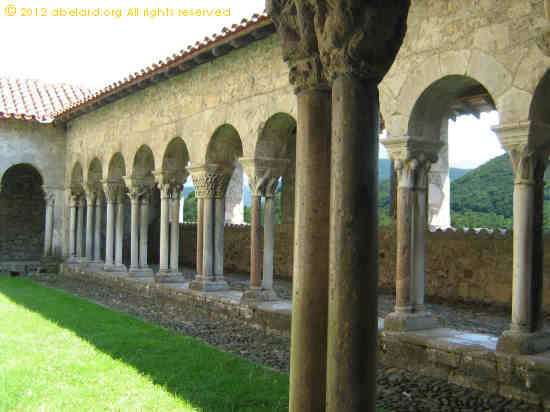
The Romanesque cloisters overlook the lower slopes of the Pyrenees
descriptions
Saint-Bertrand-de-Comminges
Here is some florid description from 1906. I’m no good at florid!
The Cathedral owes much to the romance of its position.
The Canons must have shivered in their fur
trimmed capes, their breath must have seemed white as
the snow outside, and their fingers almost too stiff to hold
a breviary, as they walked in stately procession in the wintry night, through the darkness and the shadows of the
church, into the flickering and spluttering and blazing of
the new altar's light.
The stalls now stand in solemn quiet, the last of their
Canons is long dead, and except at times of pilgrimage they seem only a deserted relic of an old-time art. There are sixty-six stalls, a canopied throne for the Bishop when he was assisting at a Mass, and still another when he himself
was celebrant. Although these carvings are not as delicate
as the best of northern work, nor as beautiful as those of
Auch, they have a very rich exuberance; and the statues of Prophets, Saints, and Sibyls, the daïs ending in its
little pointed gables, the rood-loft with its tree of Jesse, and the reredos-unfortunately painted, but no less skilfully cut from solid wood,-- these are details which have
added to this large, bare church, the beauty and impressiveness of a complete and well-conceived "liturgic choir."
There is a far more haunting charm in the Canons'
Cloister than in the Canons' choir. Although beautiful,
it is not architecturally finer than many another Cloister,
its little columns are not more slender, their capitals, although
delicate and various, are not more finely carved, its arches
are not more symmetrically round, and through the arches,
is the same small close one sees in every Cloister; but toward
the mountains, the enclosing wall was not built up; and
instead of the grey monotony of stone, there is a vast stretch
of earth and heaven. The Canon, working out the struggle
of his human life in measured prayer, looked out beyond
his cloistered hilltop to the mountains and the wildernesses
of their woods. He saw the storms and winds, the rains
and blinding snows; and perhaps by very looking upon the
winter's conflict on these mountains, or on their more quiet
springs, he found, like old King David, a new and stronger
inspiration toward a holy life.
Many an hour of pure delight may be spent here by
churchman or layman of the present day. For here is the truest architectural beauty of Saint-Bertrand, and here is
felt most deeply the grandeur of its mountains and its changing skies. And here may well be realised this truth-that the far-famed reputation of the church lies not in its intrinsic worth or harmony of structure, but in its commanding position among the wild and snow-capped Pyrenees.
[p.261 on, Cloisters and cathedrals
of the south of France]
Here’s a bit more from the same source, describing another cloister.
Elne
[In Pyrénées-Orientales, seven miles south of Peripignan.]
"Dies Irae, Dies Illa," - the priestly chant from the church fell upon his unheeding ear. Then followed, in the plaintive minor of the South, "Requiescat in pace," over and
over again, - that great heart-cry of ages of mourners, - "May he rest in peace, 0 Lord!" And suddenly he thought
of the doddering old Canons who have long been "resting." resting in the cloister-close. Had he been one of these his
soul would have chafed in the groove of churchly service,
in never ending chanting to the Lord; and he imagined,
years ago and here in Elne, some Canon's soul that must
have been like his. When he escaped from endless Psalms,
he went-nay, sometimes he ran-to the church-tower ; and
there, in churchly parlance, he "studied God in His great
nature." But in reality he listened to the strong sea winds
that buffeted about the tower, and he liked it when they
blew him back against the wall. And, best of all, he liked
dark days, when clouds were racing in the sky, when the
sea beat in heavy waves, and when the mountains seemed
to grow blacker and more ominous against the heaven.
Then followed other days, when he went from the dim
church into the Cloister; and its calm and light and quiet
beauty wooed him from weary prayers and thoughts of
penance to patience and to peace of soul. And so, for this
Canon, years went on; and Time at last found him an old,
old man. He could no longer run into the tower, but
climbed up slowly, step by step, leaning heavily on the
wooden rail. And for these climbs, he chose the clearest days, when the sun shone joyously in the blue southern
sky, and he thanked God the storms were over and that
the sea lay beautiful and calm. And when his old, worn,
tired eyes were dazzled with the dancing of the waters he
tottered down into the silent Cloister. He could no longer
see to read his Missal, so he wandered slowly round the
walks, stopping for a moment at this pillar, and then at that.
And perhaps some one saw him as he slowly straightened
up, and reached to pass his trembling fingers over some
carving of a Bible story he had loved to see; perhaps they
saw him when he shook his head over some old tale too
frankly cut in the stone, or as he smiled when his fingers
found the little Infant Christ and His young Mother.
[p.182 on, Cloisters and cathedrals
of the south of France]
the cloisters
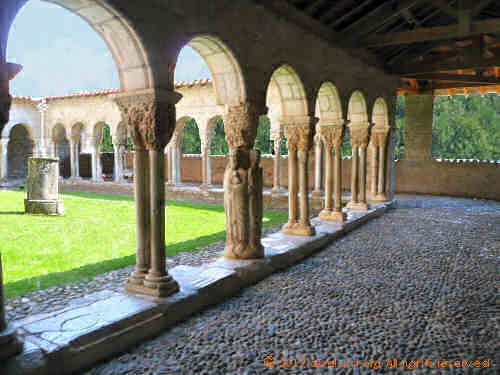
Romanesque cloisters at Saint-Bertrand-de-Comminges
The double columns second from the left is made up
of the Four Evangelist, each holding his symbol.
The gorgeous yet peaceful Romanesque cloisters originate from the 11th century, but they have been altered several times. The four galleries surround an open space, making a courtyard. Three galleries are Romanesque, including the southern one that, unusually, is open and provides a view over the hillside beyond.
- The shape of the cloisters is uneven, reflecting the uneven nature of the land beneath it.
- Three of the galleries (sides) of the cloisters are Romanesque.
- The northern gallery, next to the cathedral, was completely rebuilt during the 15th and 16th centuries, having flamboyant Gothic vaulting. There are seven tombs of monks, benefactors and regular visitors.
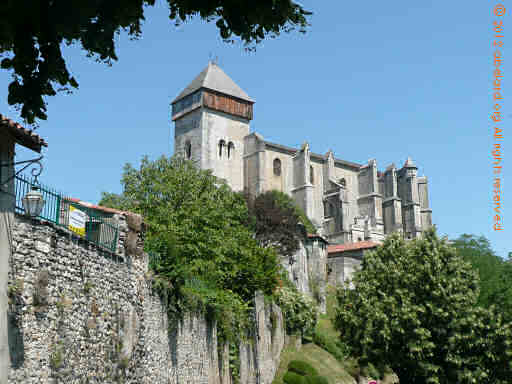
a fortified jewel
Saint-Bertrand-de-Comminges, known as the cathedral of the Pyrenees, is a glorious and beautiful little city with nigh on ten centuries of history. Buried in the Pyrenees mountain range, the city and the cathedral have a long history. The town is remarkably well-preserved, but now has shrunk to a population of about two hundred from the teeming thirty thousand of the early first millennium.
Successively a Celtic fortification - an oppidum, a Roman town and a medieval city, Saint-Bertrand-de-Comminges became one of the great places of culture, art and pilgrimage at the heart of the central Pyrenees.
Whatever the route taken toward Saint-Bernard, the traveller sees the cathedral, a fortress rising from the rock, with the mountains as background.
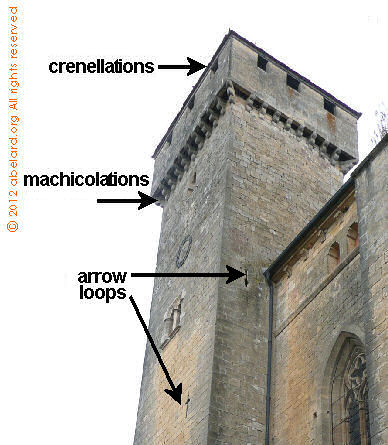 |
A fortified church has features that are more usually part of a castle’s defences.
Crenellations are walls with lower and higher parts that provide cover for archers protecting a building. The cut-out, lower parts are called crenels.
Machicolations are openings in floors that project beyond the castle wall. Missiles (and boiling oil) can be dropped on unwanted visitors below.
Arrow loops, or slits, were used through which to fire arrows with minimum exposure to the opposition.

The southern parts of France were rather lawless, and the many fortified churches provided somewhere to shelter from the latest marauders, whether Vandals, Burgondes, attackers of sheltering Cathars or the English.
Like many other towns, Saint-Bertrand-de-Comminges was much attacked and besieged. In times of alarm, the townsfolk would run to a place of safety and security. Thus the fortified church was an essential part of the little town’s defences, as is occured in Beaumont-du-Périgord. |
Beaumont-du-Périgord, Dordogne
Main tower of fortified church of Saint-Laurent-et-Saint-Front
(XIIth-XIVth centuries) |
|
| |
a bit of history
- a Roman colony: Lugdunum Convenarum
In 72 B.C. General Pompey, returning from a victorious campaign in Spain, founded at the foot of the hill a Roman town to defend the pass to Spain through the valley of Aran. This town, Lugdunum Convenarum, prospered and grew to 30,000 inhabitants.
In 408 A.D., the Vandals sacked the town, forcing the people to retreat to the Celtic oppidum.
In 585 A.D., the Burgondes, a Germanic people from the shores of the Baltic Sea,
devastated the site entirely, which remained trashed during five centuries.
- a bishop of the Gregorian reform: Bertrand de Isle-Jourdain
Life restarted on the ancient site in 1073,when a knight from the family of the Counts of Toulouse, Bertrand de l'Isle-Jourdain, previously elected as canon at Toulouse, was named as the bishop of Comminges. He rebuilt the town from its ruins, constructing on the acropolis a Romanesque cathedral and cloister. This important spiritual place became a stopping point for medieval pilgrims going to Saint-Jacques-de-Compostelle
In the 1218, Bertrand was canonised and the town’s name was changed from Lugdunum Convenarum to Saint-Bertrand-de-Comminges.
- In the 14th century, pope Clement V commissioned and financed the building of a Gothic cathedral, which incorporated the Romanesque one. By 1350, the shell of the nave was finished and the current bishop, Hughes de Chatillon started the flamboyant gothic Notre-Dame chapel, with its palm-shaped vaulting, to the north. This was finished in the 15th century.
- In the 16th century, Bishop Jean de Mauléon (Bishop from 1523-1555) financed the creation of Renaissance cathedral elements.
|

|
cathedral
dimensions
- Nave length
- 55 m/ 180ft (from chevet to the tower)
- Nave width
- 16 m / 50 ft
- Nave cross-ribbed vault
- Height: 28 m / 85 ft
- Narthex pillar bases
- Circumference: 11.45 m / 37 ft
- Height
- Bell tower: 33 m / 108 ft
-
choir and stalls
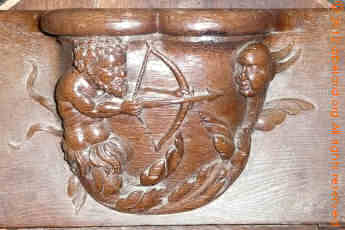 |
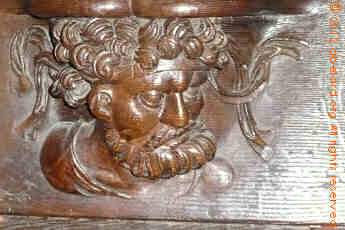 |
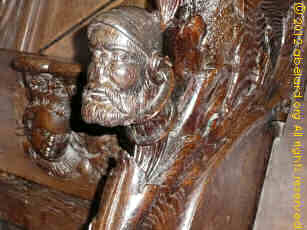 |
above: misericordes
left: a hand/arm rest carving between two stalls |
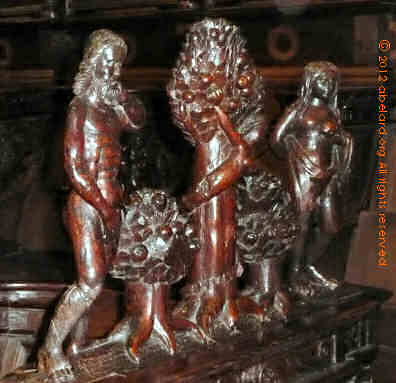
right: Adam and Eve with the Tree of Knowledge
below: stalls, arm rests and misericordes - a more general view |
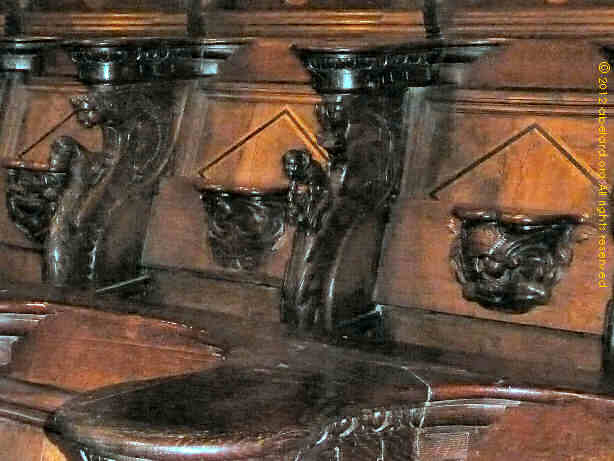 |
The choir and its stalls are not up to the the standard of those at Auch, but they are still very fine.
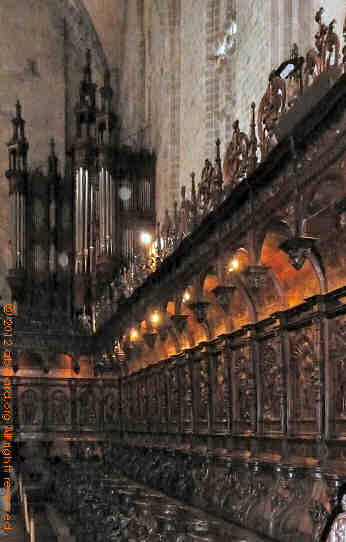
Part of the choir and its stalls, with the organ behind
the
organ
The sixteenth century organ, originally designed and built by the bishop and major donor of that time, Jean de Mauléon, dates from 1523.
Remarkable for its corner position and its five ribbed Corinthian column supports, this organ is the only like this in Europe. Sixteen metres high, there are three keyboards and forty-one pipes. However, only twelve are original pipes, the rest having been requisitioned during the Revolution and melted down for the lead and tin.
The organ was restored in 1974. It is regarded as one of the best classical organs in France.
accessing the cathedral
The cathedral is divided into two parts - the non-paying/free part and the paying part. The cathedral plan shows the barrier in blue. To the left is free, to enter the part to the right you must pay.
To enter the free part, you mount the external steps and enter by the West portal. From there, you can look at the 16th century organ, the rood screen, and walk in the pre-nave. However, this is not mightily interesting.
The paying part is entered by a door from the cloisters [marked on plan above], after passing through the Visitors Centre. Here, after paying and receiving an information leaflet and audio guide equipment (if wanted), you cross loose gravel to the cobbled cloister. From there, you may enter the southern ambulatory and the apse, as well as the choir, sanctuary and chapels.
The Treasury (marked in magenta on the plan above) is at the top of some rather old and uneven steps.

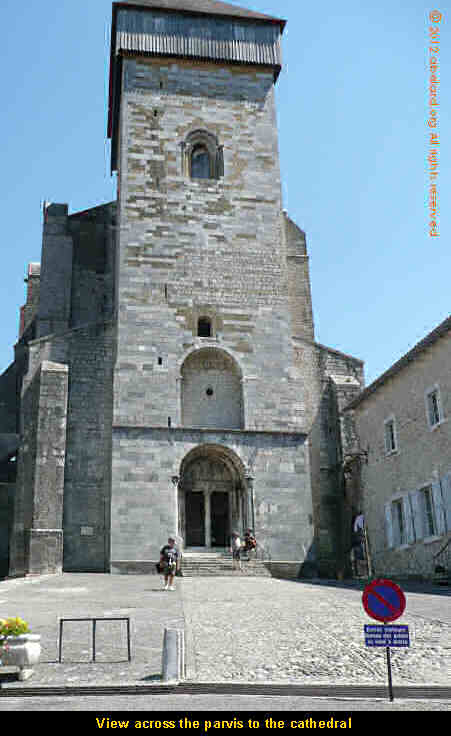 If you are not reasonably fit, you will need to be intrepid and determined, and to exercise care and initiative to visit the town and the cathedral. If you are not reasonably fit, you will need to be intrepid and determined, and to exercise care and initiative to visit the town and the cathedral.
Saint-Bertrand-de-Comminges is located on a steep hill with the cathedral at its summit. [The Google satellite map below includes some approximate heights.] For able people, this means walking up, down and across slopes. For those with mobility problems, it requires caution and probably an able helper. The town streets are steep and rough, difficult for wheelchairs whether powered or not.
From the car parking, near some of the Roman remains
at the base of the hill, a little road train runs up to the cathedral, with stops at various points on the way.
The parvis (the area in front of the cathedral) is substantially steeper than it looks in this photograph. It has also a seriously rough surface. The black strip in the foreground is almost a cattle grid. The entrance to the free part of the church is through the arched doorway you can see ahead, while the entrance to the visitors centre and the cloister is in the shadowed area to the right of the steps.
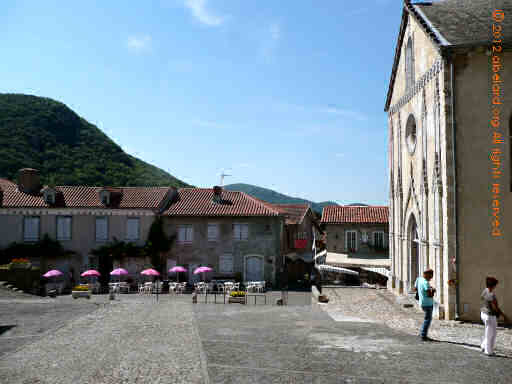
View from the cathedral, across the parvis and towards the town
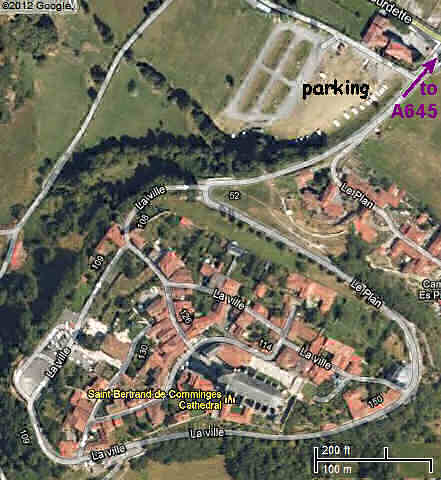
opening
times and entrance charges
- June to September:
- Mon-Sat: 09:00-19:00
Sat: 08:30-18:00/8:30am-6pm
Sun & religious holidays: 14:00-19:00/2-7pm
- February & March:
- Mon-Sat 08:30-17:00/8:30am-5pm
Sun & religious holidays: 14:00-17:30/2-5:30pm.
- April & October:
- Mon-Sat: 10:00-12:00 & 14:00-18:00/10am-noon & 2pm-6pm
Sun & religious holidays: 14:00-18:00/2pm-6pm
- May:
- Mon-Sat: 09:00-18:00/9am-6pm
- Sun: 14:00-18:00
- November, December and January:
- Mon-Sat 10:00-12:00 & 14:00-17:00/10am-noon & 2pm-5pm
Sun & religious holidays: 14:00-17:00/2-5:00pm.
- [Of course, these times may change.]
Entrance fees:
- Visit with audio-guide [passport, car keys or similar deposit required for equipment]:
- 4€ individuals;
- 3€ per person in groups over 10 people;
1.50€ students and children
Reservations and information: Tel. 05 61 89 04 91, email: olivetains@wanadoo.fr
(The workers speak English to some degree.)
driving to Saint-Bertrand-de-Comminges
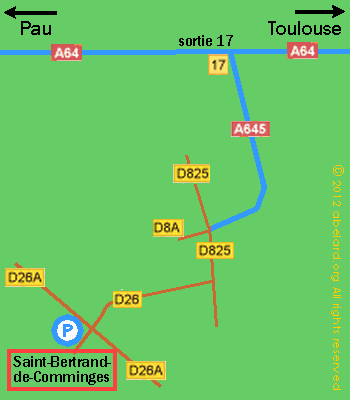
Saint-Bertrand-de-Comminges is a small town located in the countryside. To reach the town from the A64 autoroute - the Pyrénéenne - the most efficient method is by using the off-shoot A645 autoroute, leaving the A64 at sortie 17 [exit 17].
Background
facts |
Saint-Bertrand-de-Comminges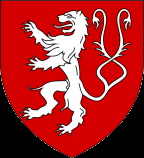 |
Saint-Bertrand-de-Comminges
is in Département 31 - Haute Garonne.
The post code is 31510.
approximate population
: 270
average altitude/elevation : 515 m
- cathedral dimensions
- height of bell tower : 33 m
nave length: 55 m / 180ft (from chevet to the tower)
nave width: 16 m / 50 ft
|

- Some reference keywords/tags:
- cathedrale, Saint-Bertrand-de-Comminges, cloisters, choir stalls, Gothic
architecture, statue, iconography, symbol, Lyons, Laon, Amiens, Auch, Poitiers, Bourges, Tours, Beauvais, Rouen, Notre-Dame
de Paris, Chartres, Dax Cathedral, map, diagram, diag,
illustration, photos, image, images, photograph, picture,
pics,
bibliography
Cloisters and cathedrals of the south of France, vol.II
by Elise Whitlock Rose |


|
published by G.P. Putnam’s Sons, the Knickerbocker
Press, 1906
ASIN: B00085SHRK
amazon.com

General Books LLC, 2009
scanned reprint, text only
ISBN-10: 0217455573
ISBN-13: 978-0217455572
£10.48 |
-
- Comminges:
- The word Comminges comes from the progressive distorting of the Latin word convenae, which was the name for the Aquitaine and Gascon people who lived in the town of Lugdunum Convenarum. The Convenae were adventurers, nomads, brigands even, who based themselves on the heights, whereas the pastores occupied the plain.
-
- Lugdunum:
- The hill of Lug - a Celtic god of intelligence, who gave wisdom and magic capacities to kings.
-
- Beaumont:
- Beaumont-du-Périgord [in Occitan, Bèlmont de Perigòrd] originally was a bastide town. It was founded in 1272 in the name of Edward I, by Luke Thaney, Seneschal of Guyenne. Beaumont still has remnants of its fortified walls, some houses à cornières and a medieval door recently restored - the Luzier or Lusies Gate.
The town officially changed its name to Beaumont in 2001.
|
















